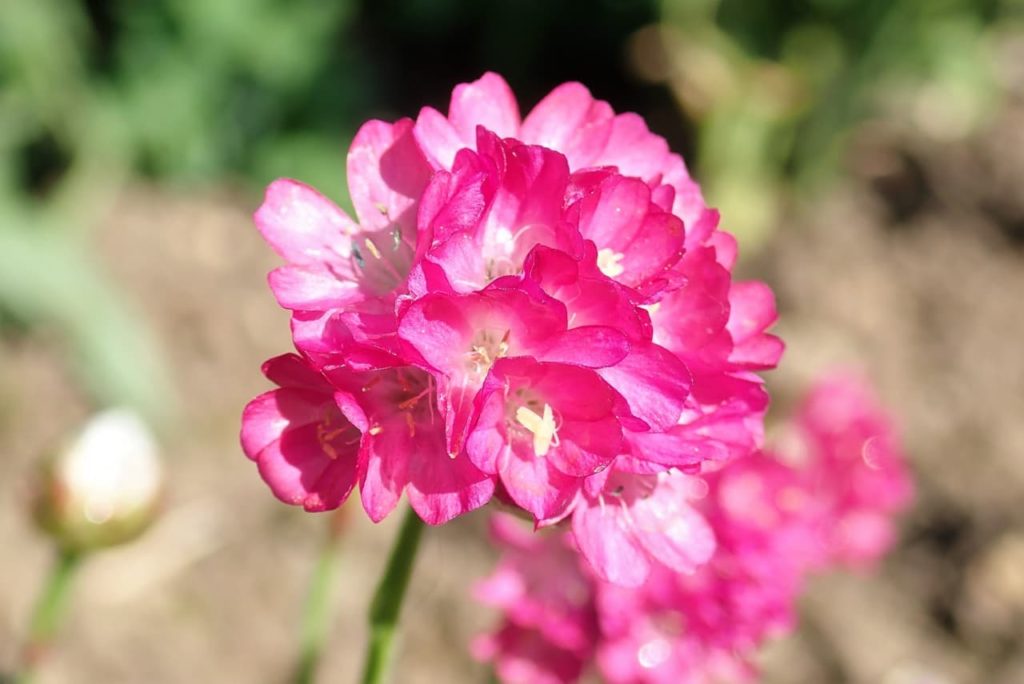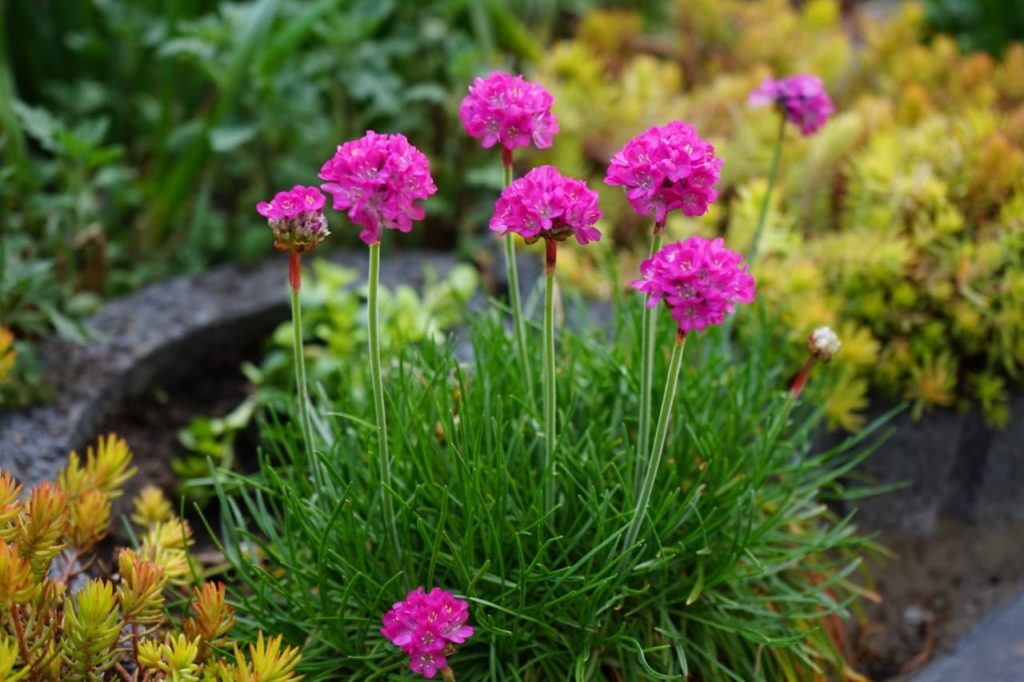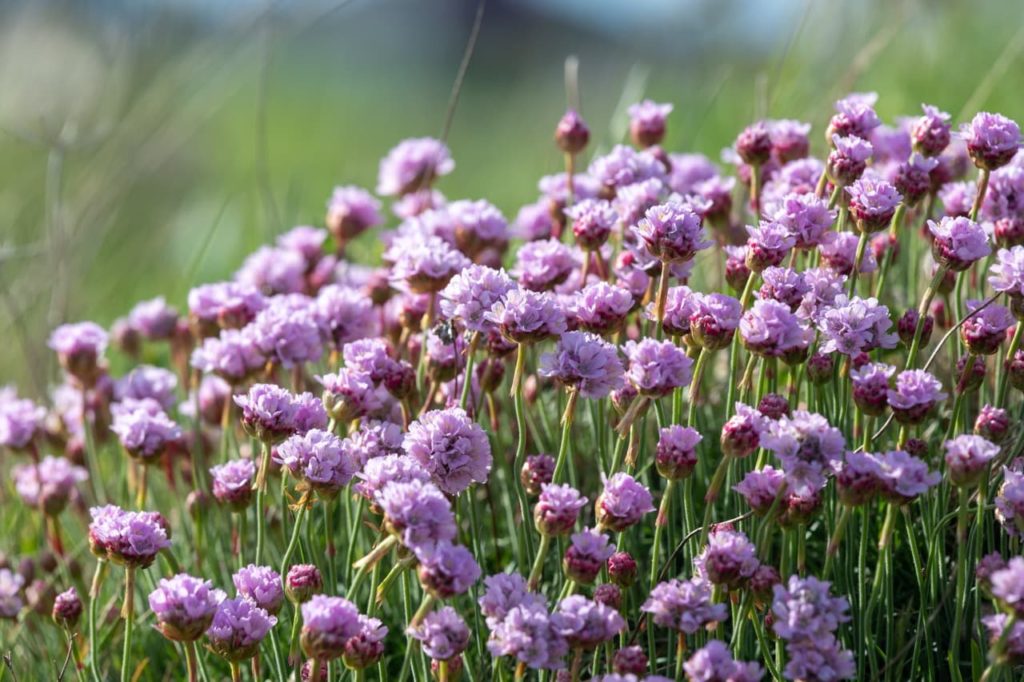ALPINES > ARMERIA
Reviewed By DAN ORI

Dan has over 27 years’ under his belt caring for plants and gardens. Working as a Horticultural Instructor and Consultant, he draws on a diverse range of experience that includes working as a Head Gardener, Tree Surgeon, Garden Centre Trouble Shooter, and writer of academic papers. Dan has a Level 3 Diploma in Horticulture and is currently a candidate for the RHS’s most prestigious award – The Master of Horticulture.
Requiring virtually zero maintenance, Armeria is a tough evergreen that makes do with poor soil and tolerates salt-spray.
Displaying foliage rather like brilliant green grass, this prepossessing little plant produces masses of pompom-like flower heads in gorgeous hues for up to three months in the summer.
Armerias are justly prized for being impervious to salty air and sea spray and are also rightly valued for being perfect for rockeries and ground cover.
However, when those are the lenses through which you see Armerias, you may forget that they are also charming, decorative, flowering evergreens that are terrific in a wide planter or as companion plants.
They can also be planted into odd nooks, crevices and holes in walls, as long as they get full sun.
Overview
| Botanical Name | Armeria |
| Common Name(s) | Sea Thrift / Sea Pink / Cliff Rose |
| Plant Type | Perennial |
| Native Area | South America and the British Isles |
| Hardiness Rating | H4-H5 |
| Foliage | Evergreen |
| Flowers | Small, cup-shaped flowers held in dense, pompom-like clusters in shades of pink, purple, red and white |
| When To Plant | May to June |
Sunlight
Preferred
Full sun
Exposure
Exposed / Sheltered
Size
Height
0.1 – 0.4M
Spread
0.1 – 0.4M
Bloom Time
May to July
Soil
Preferred
Sand or loam
Moisture
Well-drained
pH
Acidic to neutral
The numerous species in Genus Armeria are native to the entire temperate Northern Hemisphere, the Mediterranean and South America.1Armeria (DC.) Willd. (n.d.). Kew Botanic Gardens. Retrieved August 23, 2023, from https://powo.science.kew.org/taxon/urn:lsid:ipni.org:names:30024238-2
Armeria maritima is native to the British Isles and is a fairly common sight on sea cliffs and other coastal areas.2Thrift (Genus Armeria). (n.d.). iNaturalist United Kingdom. Retrieved August 2, 2023, from https://uk.inaturalist.org/taxa/60479-Armeria

Armeria foliage is nothing if not grass-like.
Out of season, the plant appears to be slowly-spreading clumps and hummocks of wild grass of a light, bright shade of green – but during the blooming season, it is coated with dense, pompom-like flower heads composed of tiny little flowers, rising well above the foliage.
Many of the flowers are nectar-rich, further enhancing your garden by attracting swarms of butterflies and bees.
Common Types
Armeria maritima is the species plant that is native to the UK.

It grows to about 15cm tall and the hues of its flowers are on the pink to purple spectrum, typically a bright tone of magenta.
Two of its cultivars include:
A. maritima ‘Alba’

Bearing pure white flowers, this cultivar has a height of about 20cm and a spread of 30cm.
A. maritima ‘Splendens’

Growing to about 20cm with a slightly greater spread, its flowers are of a rich, vibrant, pink hue.
And finally – not a native but an import from Spain that has been awarded the RHS’s Award of Garden Merit:
Armeria caespitosa

This mat-forming species grows to merely a few centimetres tall but spreads to about 30cm.
It bears soft, pastel pink flowers at nearly the same level as the grass-like leaves.
How To Grow Armeria
Although you can certainly start Armeria seeds in pots for later transplanting, these steps are superfluous because this plant lends itself to direct sowing.
Armeria seeds may be sown in the open ground after the soil has warmed up sometime in spring up until early summer, as well as in autumn, avoiding the warmest and coldest periods of the year.

Dampen the soil first.
Then, seeds should be nudged by a finger into the soil or placed on the ground and thinly sprinkled over with soil.
Keep the sowing area continuously moist until the seeds germinate.
Armeria plants should eventually be spaced by about one-half the spread of the variety or by about 20cm for a fuller look.
Preferred Aspect
These tough plants have no preference as to aspect or exposure whatsoever.
All they need is a position in full sun.
Soil Requirements & Planting
The more nutrient-rich and fertile the soil, the more poorly Armerias will perform.
Dense and poorly-draining soils will also not work out.

Provide a loose, gritty, gravelly, sandy loam which will drain very well.
Armerias may be purposed almost anywhere and used in nooks, rockeries, beds, and holes in walls.
Simply transplant this tough plant in late spring to autumn and water it in.
Armeria Care
Armeria are virtually zero-care plants.
They cannot tolerate full shade, poor drainage or overly-rich soil, but these one-time requirements do not fall under ongoing care.
Just plant them in full sun in the right type of soil and they’re all set.
Watering & Fertilising
Armerias are ideal for forgetful gardeners as they require little water.
Water young plants regularly but conservatively by merely dampening the ground.
In many regions of the UK, mature Armeria plants’ low water needs will be met by rain.

However, you should water during prolonged dry spells and periods of hot weather.
Armeria do not need to be fertilised and improper feeding may do more harm than good.
If you wish to fertilise them, do so once in spring with a pinch of succulents fertiliser or a mix of banana peel and wood ash.
Sprinkle or work into the ground away from the roots and water it in.
Pruning & Deadheading
Another plus point for these no-care plants is that they do not need to be pruned.
It is not necessary to deadhead Armerias, but it is you can do so if you want to trigger fresh blooms.
Using a pair of scissors or mini-secateurs, snip off the faded flower head’s stalk as close to the ground as possible.

I find it easy and efficient to hook the back or lower blade around the stalk, partially close the blades, slide it down the stalk and then snip.
This way, there’s no danger of cutting anything you don’t want to cut.
Common Problems
As long as sea thrifts are positioned in full sun in open ground, these evergreens are virtually disease-free and pest-resistant!
The most frequent problems that may arise would be traceable to human error, such as poorly-draining soils and overwatering.
“You will normally find Armeria on sale in garden centres from April and these will be found with the herbaceous perennials or in the alpine plant section,” shares Horticulturist Dan Ori.
“This is a big clue to Armeria’s preferred growing conditions and where best to plant, as it will thrive in a rockery and well-drained conditions.”
FAQs
Can You Grow Armeria In Pots?
Armeria can certainly be grown in pots but this mat and clump-forming evergreen will look awkward in a standard, semi-conical pot regardless of its size.
To show it off to best advantage and amplify its form and habit, try growing it in a wide planter.

A window box is another possibility as long as it is placed in a full sun spot.
Can This Plant Be Divided?
Yes, every 3-4 years you can divide an Armeria to create a new plant or two.
The best seasons to do so are early spring and early autumn.
Do Armeria Plants Tend To Spread?
Yes, Armeria self-seeds quite readily which is its mode of spreading.
Assuming flowers are not deadheaded, Armerias will form a pretty, ever-growing colony around a mother plant over time.
References
- 1Armeria (DC.) Willd. (n.d.). Kew Botanic Gardens. Retrieved August 23, 2023, from https://powo.science.kew.org/taxon/urn:lsid:ipni.org:names:30024238-2
- 2Thrift (Genus Armeria). (n.d.). iNaturalist United Kingdom. Retrieved August 2, 2023, from https://uk.inaturalist.org/taxa/60479-Armeria


